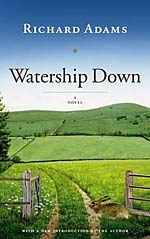
![]() Rhondak101
Rhondak101
7/4/2014
![]()
The stamp from the used book store in the front of my edition of Richard Adams' Watership Down tells me that this is truly a bucket-list book. I must have purchased this book in the late-eighties. It has made every move with me since then, but I've never read it. For this reason, I placed it on my 35 list at the beginning of the 2014 RYO challenge and then added it to the Bucket List challenge as well.
I can't even been to tell you why I didn't read it years ago, but more recently I avoided it because I decided it would be sappy and sad. After all, it is a story about anthropomorphic rabbits in jeopardy. (Remember, I'm of the generation who was emotionally scarred by the death of Bambi's mother.) I am happy to say this book is neither sappy nor sad.
I wish I had known earlier that Adams had patterned his story on great mythic tales. Virgil's Aeneid, Homer's Odyssey, Jason and the Argonauts and the Rape of the Sabine Women all inform Adams' narrative, as it is the story of young male rabbits who leave their warren on the eve of its destruction to establish a new home. Once they build their new warren, they must find female rabbits to come help them populate it. The main characters are Hazel and his brother Fiver. Hazel has leadership traits, while Fiver has the gift of prophecy, which some rabbits do possess. Fiver sees the destruction of the rabbits' original warren before it happens and, like Cassandra, tries to convince everyone to leave. The group of rabbits who do leave the warren all possess distinct talents or skills, like the Argonauts or Odysseus' sailors. Besides the leader and the prophet embodied by Hazel and Fiver, Bigwig provides the strength for the group; Holly and Silver provide security; Blackberry lends his ingenuity; Blueberry is the jester; and Dandelion, the storyteller. The other rabbits who journey with Hazel or join the group along the way also have distinct personalities and allegiances. This is hard to accomplish with so many characters, but Adams does a good job.
This book was nominated for the Mythopoeic Award in 1975. A reason for this is the complex Lapine culture that Adams creates. Adams develops a language that explains nature and culture through a rabbit's perspective. For example, "silflay" means "to go above ground to feed"; "fu Inlé" means "after moonrise"; and "tharn" has many meanings, but my favorite is "hypnotized with fear" because we have all seen a rabbit in this state. The rabbits, usually Dandelion, tell stories that further reveal the Lapine culture. Not surprisingly, the rabbits revere a trickster figure called El-ahrairah, who is informed by Brer Rabbit and his African analogs. There is a sun god, Lord Frith and a moon god/death figure called the Black Rabbit of Inlé. Through these tales, the reader learns of the rabbit creation myth, a flood story and their otherworld.
In short, Watership Down is a richly embroidered adventure tale, containing journeys, battles, raids and espionage. There's lots of human drama, but I never forgot that I was reading about rabbits and experiencing another culture.